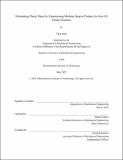| dc.contributor.advisor | Gilbert, Daniel | |
| dc.contributor.author | Spitz, Talia | |
| dc.date.accessioned | 2022-08-29T16:14:42Z | |
| dc.date.available | 2022-08-29T16:14:42Z | |
| dc.date.issued | 2022-05 | |
| dc.date.submitted | 2022-06-14T19:35:38.776Z | |
| dc.identifier.uri | https://hdl.handle.net/1721.1/144831 | |
| dc.description.abstract | As 3D printing becomes more popular, the issue of excess plastic grows. In response, companies and hobbyists have developed recycling systems to turn waste material back into 3D printing filament. In the Laboratory for Manufacturing and Productivity (LMP), students use injection-molding and thermoforming machines, and 3D printers for prototyping. All of these tools generate waste products; LMP throws out barrels of plastic every semester. To better align with MIT’s commitment to fighting climate change, LMP needs to cut down on its excess plastic. Filament extrusion and injection molding testing was conducted to pave the way for the LMP to switch over to recycling its own plastic into 3D printer filament and pellets for injection molding. The experiments were promising and confirmed that LMP has the potential to be a model for other labs looking to be more environmentally friendly. Next steps include sourcing a plastics supplier, filament extrusion system and grinder, as well as setting up plastic storage and documenting the recycling system. | |
| dc.publisher | Massachusetts Institute of Technology | |
| dc.rights | In Copyright - Educational Use Permitted | |
| dc.rights | Copyright MIT | |
| dc.rights.uri | http://rightsstatements.org/page/InC-EDU/1.0/ | |
| dc.title | Eliminating Plastic Waste by Transitioning Machine Shop to Produce Its Own 3D Printer Filament | |
| dc.type | Thesis | |
| dc.description.degree | S.B. | |
| dc.contributor.department | Massachusetts Institute of Technology. Department of Mechanical Engineering | |
| mit.thesis.degree | Bachelor | |
| thesis.degree.name | Bachelor of Science in Mechanical Engineering | |
